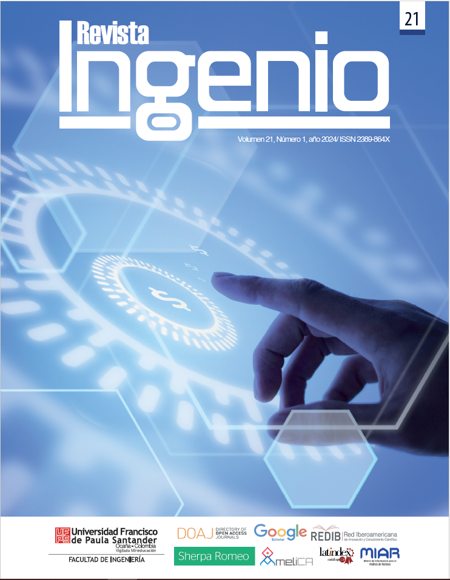Environmental impact study on alternative sanitation systems for the solution of wastewater discharges in the coastal area of the district of Riohacha, in La Guajira, Colombia.
Estudio de impactos ambientales sobre alternativas de sistemas de saneamiento para la solución de vertimientos en la zona costera del distrito de Riohacha, en La Guajira, Colombia
Main Article Content
This research highlights the urgency of addressing pollution in the marine waters and coastal zone of the Riohacha district, aggravated by the discharge of untreated municipal wastewater. The lack of an efficient treatment system has caused soil damage, destruction of marine fauna and flora, impacts on local health, and a decrease in tourism, which is vital for regional income. To solve this problem, three basic sanitation alternatives are proposed: conventional treatment plant, submersible membrane bioreactor and submarine outfall. The environmental impact assessment using the Leopold matrix is essential to understand and compare the possible effects of these alternatives.
The Environmental Impact Assessment (EIA) provides crucial data to identify the environmental impacts of each option, facilitating sustainable decision making. This approach demonstrates a commitment to protecting the local environment. Community and other stakeholder involvement will complement this approach, and the results of the EIA and its influence on the choice of the most appropriate alternative are eagerly awaited.
Downloads
Article Details
Y. Mendoza, F. Castro y J. Marin, "Eichhornia crassipes como Tratamiento Biologico de aguas residuales. Fitorremediación con plantas acuáticas como alternativa de tratamiento para aguas domésticas," 2019.
T. Burkitt, A. Dixon y M. Simon, "Assessing the environmental impact of two options for small-scale wastewater treatment: comparing a reedbed and an aerated biological filter using a life cycle approach," Ecological Engineering, pp. Volume 20, Issue 4, 2003. DOI: https://doi.org/10.1016/S0925-8574(03)00007-7
A. Hospido, M. T. Moreira, M. Fernandez y G. Feijoo, "Environmental performance of a municipal wastewater treatment plant," The International Journal of Life Cycle Assessment, pp. 9,261–271 , 2004. DOI: https://doi.org/10.1007/BF02978602
U. Jeppsson y D. Hellstrom, "Systems analysis for environmental assessment of urban water and wastewater systems," Water Science & Technology, pp. 46(6-7):121-9, 2012. DOI: https://doi.org/10.2166/wst.2002.0671
E. Awad, A. Jawad y H. Al Mendilawi, "Environmental Assessment of Wastewater Treatment Plants (WWIPs) for Old Rustamiya Project," 2014.
C. Teodosiu, G. Barjoveanu and B. Sluser, "Environmental Assessment of Municipal Wastewater Discharges: A Comparative Study of Evaluation Methods," The International Journal of Life Cycle Assessment , p. 21, n°3, 2016. DOI: https://doi.org/10.1007/s11367-016-1029-5
J. Gomez Camperos, F. Regino Ubarnes y H. Y. Jaramillo, "Desarrolo de un sistema de supervisión de las variables de temperatura, presión y pH en un Biogestor Anaeróbico," Revista Ingenio, vol. 19, n°1, pp. 22 - 27, 2022, doi: https://doi.org/10.22463/2011642X.3035 DOI: https://doi.org/10.22463/2011642X.3035
E. Espinel Blanco, E. Florez Solano y J. Barbosa Jaimes, "Estudio para la generación de energía por un sistema con paneles solares y baterías," Revista Ingenio, vol. 17, n°1, pp. 9 - 14, 2020, doi: https://doi.org/1010.22463/2011642X.2392 DOI: https://doi.org/10.22463/2011642X.2392
F. Sánchez, "Identificación y Evaluación de Impactos Ambientales," 2008. chrome-extension://efaidnbmnnnibpcajpcglclefindmkaj/https://www.esap.edu.co/portal/filebase/m%C3%B3dulos_pregrado/tecnolog%C3%ADa_en_gesti%C3%B3n_p%C3%BAblica_ambiental/semestre_iv/4_identificacion_y_eva_impactos_amb.pdf
Lifader, "Matriz de Leopold: para qué sirve, ventajas, ejemplos," 2019.
L. Leopold, F. Clarke, B. Hanshaw and J. Balsley, "A procedure for evaluating environmental impact," Washington, 1971. DOI: https://doi.org/10.3133/cir645
V. Conesa, Guía metodologica para la evaluación de imapactos ambientales, 4° ed., Mexico: Mundi-Prensa, 2011.
T. Reynolds and P. Richards, "Actived Sludge," in Unit Operations and Processes in Envieronmental Engineering, 1982, pp. 411 - 489.
S. Judd, The MBR Book: Principles and Applications of Membrane Bioreactors in Water and Wastewater Treatment, 2006.
Inditex, "BIOIORREACTORES DE MEMBRANA (FT-BIO-010)," 2016. https://www.wateractionplan.com/documents/177327/558161/Biorreactores+de+membrana+%28BRM%29.pdf/5eaf2ead-d155-2a7f-d72a-63ff5548ba5f. [Accessed 01 Abril 2020].
J. Harari, P. Galluzzi , T. Cortez and S. Hora Yang, "A Study about Submarine Sewage Outfalls in the Coastal Regional of the State of Paraná- Brazil," Internationa Journal of Environmental Sciences and Natural Resources , 2019. DOI: https://doi.org/10.19080/IJESNR.2019.17.555960
Elinsubca C.A, "Debugging system for outfall (SIDES)," 2015.







